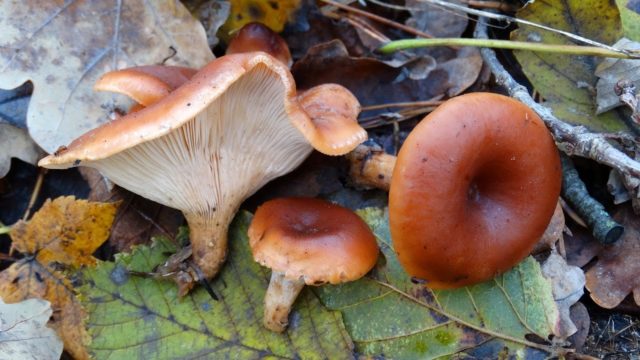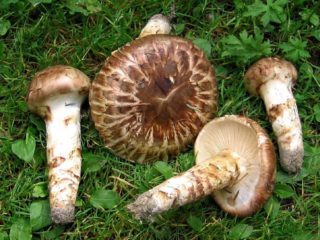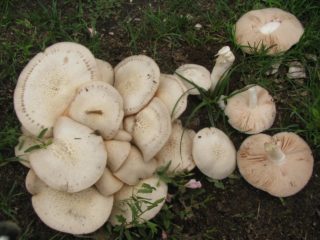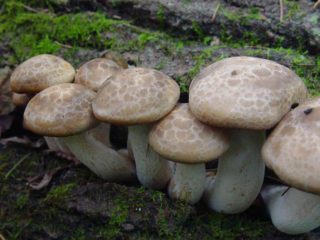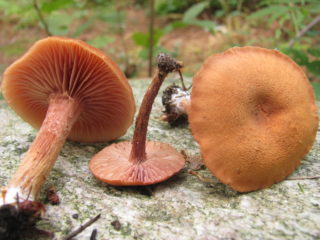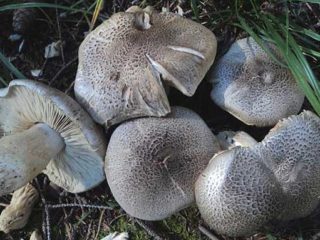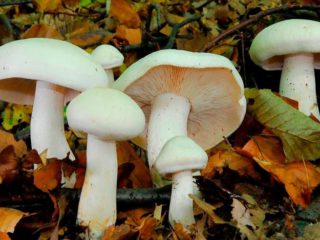Content
The water-spotted row (brown-yellow govorushka) belongs to the Tricholomataceae family, the Paralepista genus. An additional synonym for mushroom is golden ryadovka.
Where the ryadovka grows water-spotted
Ryadovka water-spotted (brown-yellow talker) is unpretentious to growing conditions. It grows on almost all types of soil. Drought tolerant. Fruiting period July-October. The peak falls in September. The mushroom is widespread in North America, Western and Eastern Europe, Central and Northern Russia, the Far East, the Urals. Grows in groups.
What does a brown-yellow talker look like
The ryadovka's cap is rather large, 4-10 cm, sometimes reaching 15 cm in diameter. The shape is flat, a tubercle is visible in the center. As it matures, the cap acquires a funnel-shaped structure. The edges are folded inward. The surface of the upper part is undefined. Basic shades: brown-yellow, yellow-orange, red, beige. The color is able to fade in the sun, then the color of the cap approaches white. Rusty spots are common.
A characteristic feature is small water droplets on the surface of the cap. After rain or in a damp forest, the skin becomes watery, slippery, matte. Depending on the weather, the shade of the upper part of the mushroom changes.
The leg is oblong, even, occasionally narrowed downwards. It grows by 3-4 cm. The thickness is 1 cm. The color of the lower part varies from white to gray. The base is white pubescent. Inside, the leg is dense, without voids, solid. The color is brownish yellow or pale ocher.
The structure of the ryadovka is water-spotted (brown-yellow talker), fibrous, mealy. The pulp is yellow, creamy. Has an aniseed scent. The taste is slightly bitter. Some mushroom pickers claim that the fruiting body smells intensely of perfume.
The plates are white, narrow, descending, often located. With age, they acquire a yellow, brown color.
Is it possible to eat a ryadovka water-spotted
Foreign mycologists claim that the brown-yellow talker is a dangerous species that contains a poisonous substance akin to muscarine. But there is also the opposite information, according to which the water-spotted ryadovka belongs to the conditionally edible subspecies of the 4th category. Russian mushroom pickers do not collect it, it is better to abandon this variety in favor of more familiar representatives.
How to distinguish a water-spotted ryadovka
The brown-yellow talker has distinctive features. But mushroom pickers without experience may confuse it with other varieties.
The row is inverted. The largest fixed size of the cap is 14 cm. On average, the diameter ranges from 4 to 11 cm. At first, the shape is convex, then it straightens out, becoming almost even. The surface of the cap is matte, brown-orange or brick-colored. Leg up to 10 cm high, oblong. The color matches the tone of the cap.The pulp is white. There is a sweetish smell. The taste is mediocre.
It grows both singly and in groups. Occurs at the foot of anthills, on coniferous litters. The active growth period is autumn. The mushroom is widespread in North America, Great Britain, Ireland.
It differs from the talker in a brown-yellow lighter ocher cap, yellow plates and a leg. In foreign sources, both varieties are considered poisonous.
The row is red. It grows in the same conditions as the water-spotted ryadovka. Mushrooms are quite similar to each other. The only difference is the lighter surface of the talker's hat, brown-yellow, and that is not always the case.
Poisoning symptoms and first aid
According to foreign mycologists, muscarine is contained in the pulp of ryadovka water-spotted. This substance leads to poisoning of the body. The first symptoms of intoxication:
- upset gastrointestinal tract;
- general weakness;
- vomiting;
- dizziness and headache;
- thirst;
- acute abdominal pain.
Diarrhea lasts for one or two days. After the body is restored, if remedial measures were taken in a timely manner.
First aid for poisoning:
- Call an ambulance or take the victim to the hospital.
- Gastric lavage is performed using a weak solution of potassium permanganate. After that, you can take any sorbing agent, for example, activated carbon.
- Give the victim an abundant drink.
- They provoke the appearance of gag reflexes.
- Use laxatives or a cleansing enema.
- If a person with poisoning is shivering, then until the arrival of an ambulance, he is covered with warmth.
You can not give the patient alcoholic beverages. Since this will only provoke the rapid absorption of the poison by the body. No need to feed a poisoned person. Better to give a warm drink. Medicines should be used after consulting a doctor. Mushroom poisoning is difficult for children and the elderly.
Conclusion
Row water-spotted (brown-yellow talker) grows on the territory of Russia in a temperate forest zone. The edibility of the mushroom is questionable. Some sources note that the water-spotted row belongs to the conditionally edible group. According to other sources, the fruit body is considered inedible, even poisonous.


